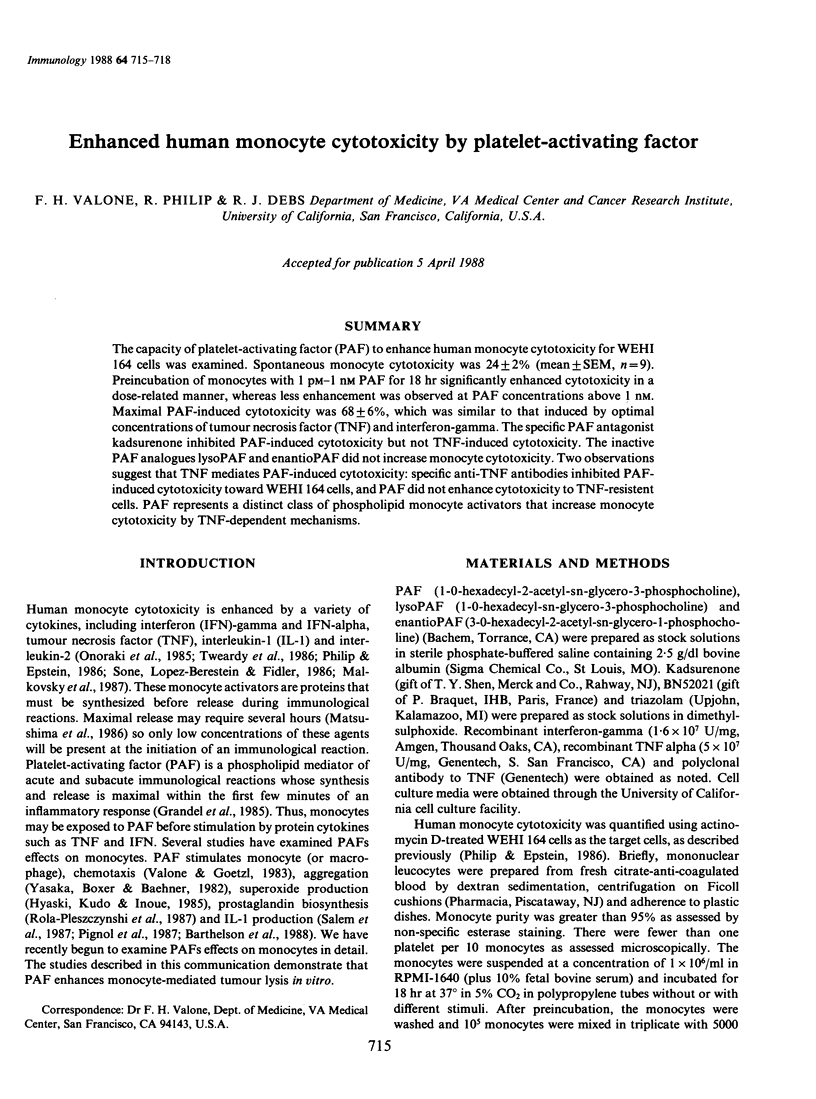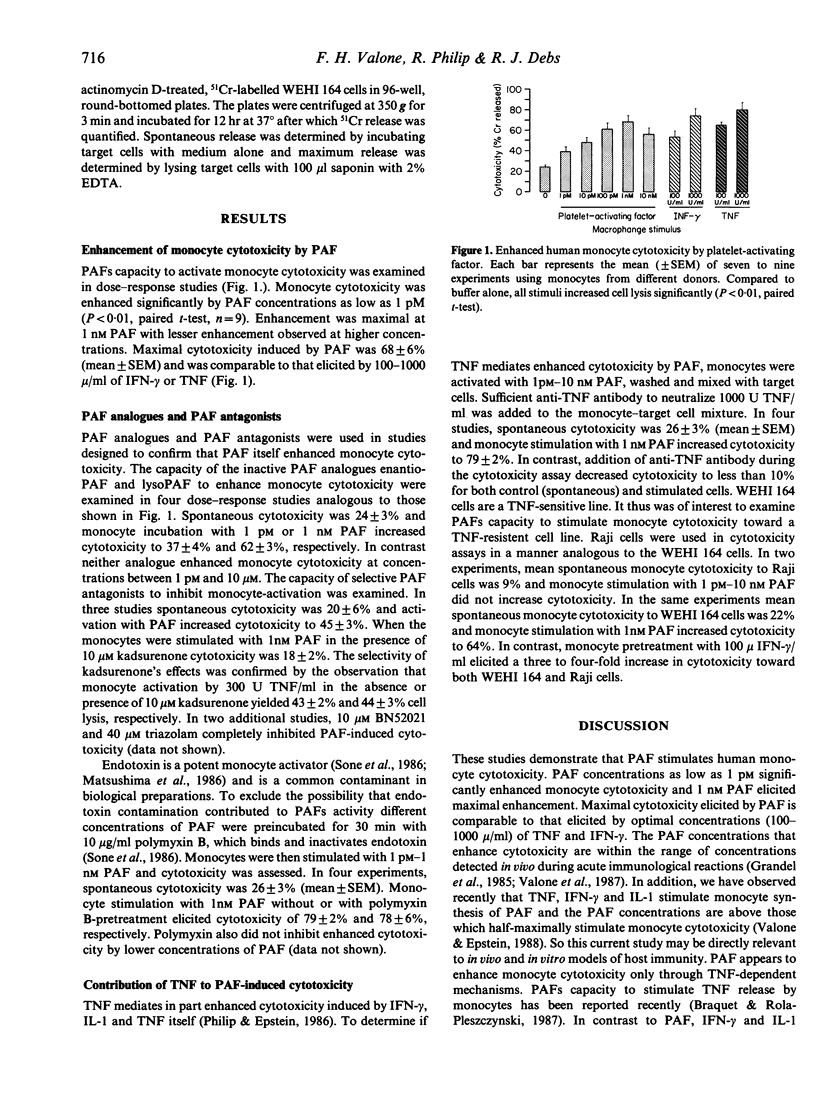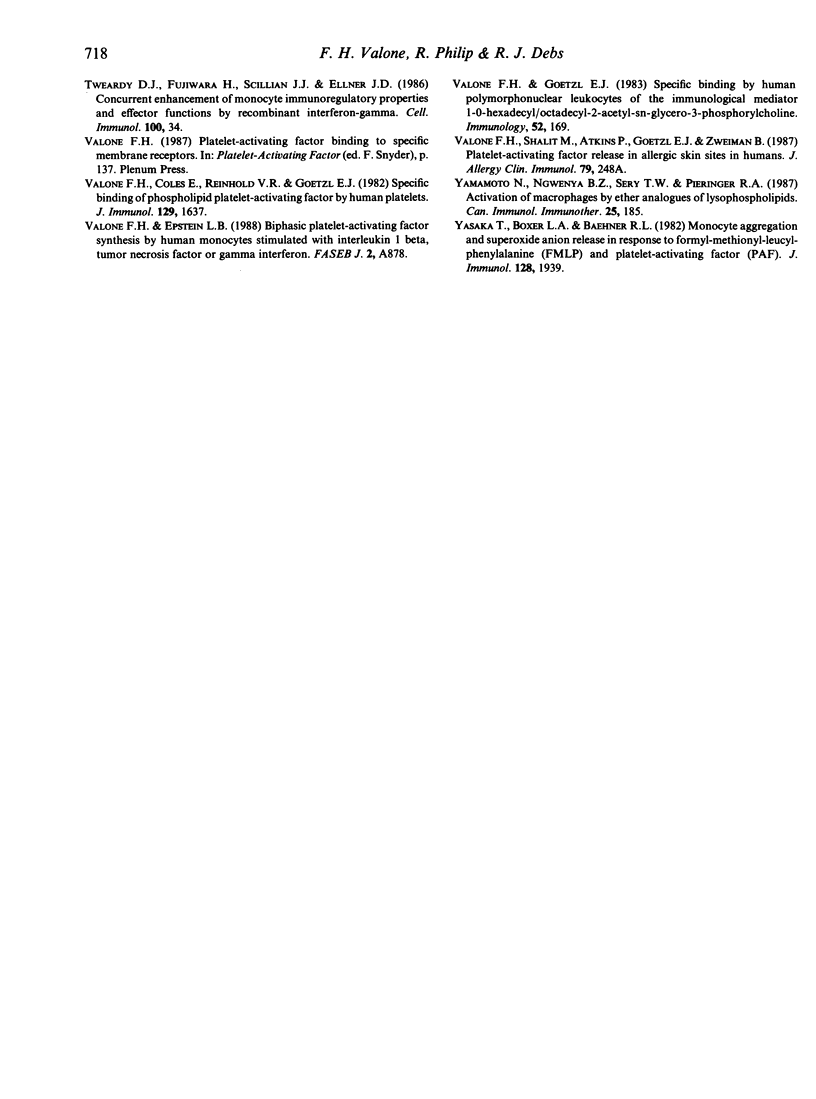Abstract
The capacity of platelet-activating factor (PAF) to enhance human monocyte cytotoxicity for WEHI 164 cells was examined. Spontaneous monocyte cytotoxicity was 24 +/- 2% (mean +/- SEM, n = 9). Preincubation of monocytes with 1 pM-1 nM PAF for 18 hr significantly enhanced cytotoxicity in a dose-related manner, whereas less enhancement was observed at PAF concentrations above 1 nM. Maximal PAF-induced cytotoxicity was 68 +/- 6%, which was similar to that induced by optimal concentrations of tumour necrosis factor (TNF) and interferon-gamma. The specific PAF antagonist kadsurenone inhibited PAF-induced cytotoxicity but not TNF-induced cytotoxicity. The inactive PAF analogues lysoPAF and enantioPAF did not increase monocyte cytotoxicity. Two observations suggest that TNF mediates PAF-induced cytotoxicity: specific anti-TNF antibodies inhibited PAF-induced cytotoxicity toward WEHI 164 cells, and PAF did not enhance cytotoxicity to TNF-resistant cells. PAF represents a distinct class of phospholipid monocyte activators that increase monocyte cytotoxicity by TNF-dependent mechanisms.
Full text
PDF



Selected References
These references are in PubMed. This may not be the complete list of references from this article.
- Andreesen R., Osterholz J., Luckenbach G. A., Costabel U., Schulz A., Speth V., Munder P. G., Löhr G. W. Tumor cytotoxicity of human macrophages after incubation with synthetic analogues of 2-lysophosphatidylcholine. J Natl Cancer Inst. 1984 Jan;72(1):53–59. doi: 10.1093/jnci/72.1.53. [DOI] [PubMed] [Google Scholar]
- Bussolino F., Breviario F., Tetta C., Aglietta M., Mantovani A., Dejana E. Interleukin 1 stimulates platelet-activating factor production in cultured human endothelial cells. J Clin Invest. 1986 Jun;77(6):2027–2033. doi: 10.1172/JCI112532. [DOI] [PMC free article] [PubMed] [Google Scholar]
- Camussi G., Bussolino F., Salvidio G., Baglioni C. Tumor necrosis factor/cachectin stimulates peritoneal macrophages, polymorphonuclear neutrophils, and vascular endothelial cells to synthesize and release platelet-activating factor. J Exp Med. 1987 Nov 1;166(5):1390–1404. doi: 10.1084/jem.166.5.1390. [DOI] [PMC free article] [PubMed] [Google Scholar]
- Grandel K. E., Farr R. S., Wanderer A. A., Eisenstadt T. C., Wasserman S. I. Association of platelet-activating factor with primary acquired cold urticaria. N Engl J Med. 1985 Aug 15;313(7):405–409. doi: 10.1056/NEJM198508153130702. [DOI] [PubMed] [Google Scholar]
- Hayashi H., Kudo I., Inoue K., Onozaki K., Tsushima S., Nomura H., Nojima S. Activation of guinea pig peritoneal macrophages by platelet activating factor (PAF) and its agonists. J Biochem. 1985 Jun;97(6):1737–1745. doi: 10.1093/oxfordjournals.jbchem.a135232. [DOI] [PubMed] [Google Scholar]
- Malkovský M., Loveland B., North M., Asherson G. L., Gao L., Ward P., Fiers W. Recombinant interleukin-2 directly augments the cytotoxicity of human monocytes. Nature. 1987 Jan 15;325(6101):262–265. doi: 10.1038/325262a0. [DOI] [PubMed] [Google Scholar]
- Matsushima K., Taguchi M., Kovacs E. J., Young H. A., Oppenheim J. J. Intracellular localization of human monocyte associated interleukin 1 (IL 1) activity and release of biologically active IL 1 from monocytes by trypsin and plasmin. J Immunol. 1986 Apr 15;136(8):2883–2891. [PubMed] [Google Scholar]
- Munder P. G., Modolell M., Andreesen R., Berdel W., Pahlke W., Oepke R., Westphal O. Generation of tumorcidal macrophages and direct selective destruction of tumor cells by membrane active adjuvants. Prog Clin Biol Res. 1983;132B:393–402. [PubMed] [Google Scholar]
- Onozaki K., Matsushima K., Kleinerman E. S., Saito T., Oppenheim J. J. Role of interleukin 1 in promoting human monocyte-mediated tumor cytotoxicity. J Immunol. 1985 Jul;135(1):314–320. [PubMed] [Google Scholar]
- Pignol B., Hénane S., Mencia-Huerta J. M., Rola-Pleszczynski M., Braquet P. Effect of platelet-activating factor (PAF-acether) and its specific receptor antagonist, BN 52021, on interleukin 1 (IL1) release and synthesis by rat spleen adherent monocytes. Prostaglandins. 1987 Jun;33(6):931–939. doi: 10.1016/0090-6980(87)90120-1. [DOI] [PubMed] [Google Scholar]
- Rola-Pleszczynski M., Pignol B., Pouliot C., Braquet P. Inhibition of human lymphocyte proliferation and interleukin 2 production by platelet activating factor (PAF-acether): reversal by a specific antagonist, BN 52021. Biochem Biophys Res Commun. 1987 Feb 13;142(3):754–760. doi: 10.1016/0006-291x(87)91478-1. [DOI] [PubMed] [Google Scholar]
- Sone S., Lopez-Berestein G., Fidler I. J. Potentiation of direct antitumor cytotoxicity and production of tumor cytolytic factors in human blood monocytes by human recombinant interferon-gamma and muramyl dipeptide derivatives. Cancer Immunol Immunother. 1986;21(2):93–99. doi: 10.1007/BF00199855. [DOI] [PMC free article] [PubMed] [Google Scholar]
- Tweardy D. J., Fujiwara H., Scillian J. J., Ellner J. J. Concurrent enhancement of monocyte immunoregulatory properties and effector functions by recombinant interferon-gamma. Cell Immunol. 1986 Jun;100(1):34–46. doi: 10.1016/0008-8749(86)90004-3. [DOI] [PubMed] [Google Scholar]
- Valone F. H., Coles E., Reinhold V. R., Goetzl E. J. Specific binding of phospholipid platelet-activating factor by human platelets. J Immunol. 1982 Oct;129(4):1637–1641. [PubMed] [Google Scholar]
- Yamamoto N., Ngwenya B. Z., Sery T. W., Pieringer R. A. Activation of macrophages by ether analogues of lysophospholipids. Cancer Immunol Immunother. 1987;25(3):185–192. doi: 10.1007/BF00199146. [DOI] [PMC free article] [PubMed] [Google Scholar]
- Yasaka T., Boxer L. A., Baehner R. L. Monocyte aggregation and superoxide anion release in response to formyl-methionyl-leucyl-phenylalanine (FMLP) and platelet-activating factor (PAF). J Immunol. 1982 May;128(5):1939–1944. [PubMed] [Google Scholar]


